Welcome back to Magic Gatherings!
The latest Magic set, Shadows over Innistrad, officially released last week, so it’s time to talk limited. This week I’ll discuss the set’s major mechanics and themes, with an eye toward general principles for drafting it. Next week I’ll delve into the colors’ strengths and weaknesses, and cover the bases of the format’s major archetypes. Let’s get to it!
The Long Shadows of Innistrad
Shadows over Innistrad returns to the eponymous gothic horror plane, one of the most popular settings in Magic‘s history. In addition to nailing the flavor and feel of its source material, the original Innistrad is fondly remembered for its deep draft environment—possibly the best of all time. Almost every card in Innistrad had a use somewhere, though their value could vary wildly: cards that were lynchpins of certain strategies were utterly worthless to other decks. As players discovered new uses for previously underappreciated gems, the format evolved, and actually became more robust the more it was drafted. It was a bit like discovering the Dampen Thought deck in Kamigawa draft, except that it happened multiple times with multiple cards over the course of the format.
Shadows over Innistrad has a lot to live up to, in other words. But my first experiences with the format have left me optimistic. SoI‘s mechanics interact in subtle ways to make for a good environment, and its cards have a lot of depth—sometimes they’re good, and sometimes they’re great, and sometimes that can even happen in the same game.
Methods to the Madness
There’s a lot going on with the mechanics in Shadows, which are more complicated than in your average set. They mesh together quite well, though, in ways that are sometimes obvious, sometimes less so.
Double-Faced Cards—The most iconic “Innistrad mechanic,” double-faced cards can transform during play to become more powerful. You always cast the front side (with the mana cost and the sun icon in the upper-left corner), but when specific conditions described on the card are met, you flip the card onto its back side.
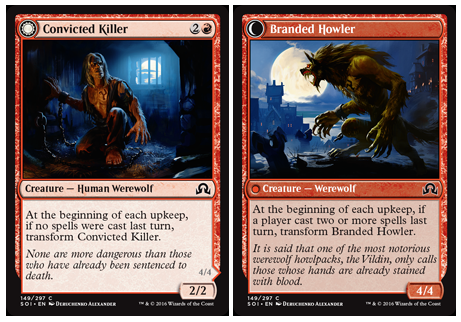
Transforming is a flexible mechanic, so these cards can do all sorts of things. The most cohesive subset are the werewolves, which all share the same transformation condition: if a turn passes with no player casting a spell, they flip from their human side to their werewolf side; if a single player casts two or more spells in a turn, they flip from their werewolf side to their human side.
Werewolves really appreciate having instant-speed cards, since a common play pattern is to pass your own turn without playing a spell to flip your werewolves on your opponent’s upkeep; it’s important to be able to cast something on your opponent’s turn, so you don’t take the full turn cycle off. By the same token, instants are good against werewolves—an end-step spell from your opponent will foil your “pass to flip” plan.
There are a lot of other transform cards, especially ones that transform from one card type to another. These work case-by-case, so read carefully.
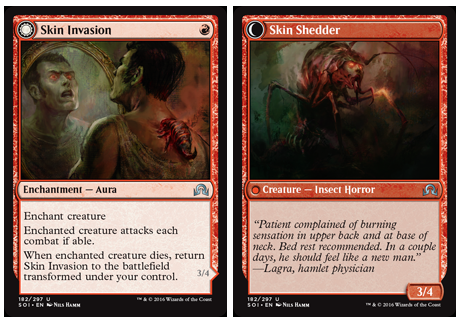
Reading some cards may be more traumatic than others.
Madness—Another returning mechanic, madness allows you to cast spells when you discard them.
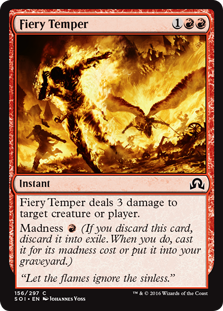
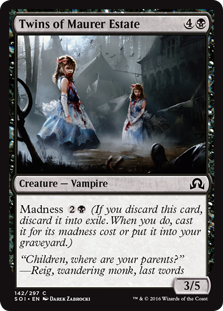
 Creature spells discarded with madness will wind up on the battlefield after you play them. Instants and sorceries take effect, then go to the graveyard as part of their resolution per normal. Occasionally, as with [mtg_card]Welcome to the Fold[/mtg_card], cards will have different effects when you play them via madness.
Creature spells discarded with madness will wind up on the battlefield after you play them. Instants and sorceries take effect, then go to the graveyard as part of their resolution per normal. Occasionally, as with [mtg_card]Welcome to the Fold[/mtg_card], cards will have different effects when you play them via madness.
Of course, to play a spell with madness, something has to make you discard it—you can’t just pitch it from your hand because you feel like it. For that reason, Shadows has a high density of effects that force discard or allow you to discard for a benefit.


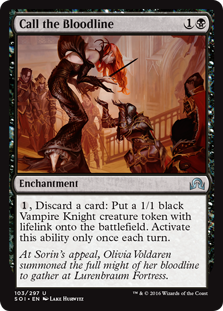 Madness usually gives a discount of a mana or two off the spell’s full price. It also has a subtle side benefit: it can give you ways to cast spells at instant speed, when you normally wouldn’t be able to. If your opponent attacks with an [mtg_card]Inspiring Captain[/mtg_card], you can activate [mtg_card]Mad Prophet[/mtg_card], discard [mtg_card]Twins of Maurer Estate[/mtg_card] to the Prophet’s ability, and use madness to cast the Twins. Essentially, you flash in a 3/5 blocker and draw a card for your troubles.
Madness usually gives a discount of a mana or two off the spell’s full price. It also has a subtle side benefit: it can give you ways to cast spells at instant speed, when you normally wouldn’t be able to. If your opponent attacks with an [mtg_card]Inspiring Captain[/mtg_card], you can activate [mtg_card]Mad Prophet[/mtg_card], discard [mtg_card]Twins of Maurer Estate[/mtg_card] to the Prophet’s ability, and use madness to cast the Twins. Essentially, you flash in a 3/5 blocker and draw a card for your troubles.
When drafting, it’s helpful to keep in mind both your madness cards and your madness enablers, the discard outlets that give you windows to cast madness cards. You’ll need a high count of both if you want your deck to run smoothly. Bear in mind that if your discard outlet is a spell like [mtg_card]Catalog[/mtg_card] or [mtg_card]Macabre Waltz[/mtg_card], you’ll need to pay the mana cost for that spell in addition to whatever the madness cost for the card you discard is, which can add up. Permanent, repeatable discard, like the ability on [mtg_card]Mad Prophet[/mtg_card], is very good in a dedicated madness deck.
Delirium—Lots of cards being discarded means lots of cards in graveyards. The third major mechanic, delirium, takes advantage of this.
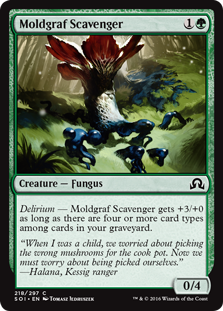
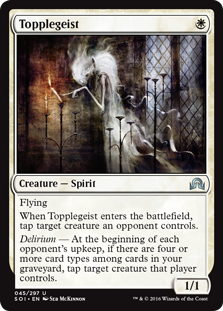
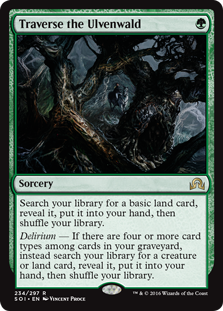 Delirium is a “threshold” style mechanic, which means that it “turns on” when a certain in-game condition is met. (The original mechanic, threshold, gave additional or alternate abilities to cards when you had seven cards in your graveyard.) In the case of delirium, you need four different card types among the cards of your graveyard. Getting creatures, sorceries, and instants into your graveyard tends to happen normally over the course of the game. Binning artifacts, enchantments, and lands usually requires a little more effort.
Delirium is a “threshold” style mechanic, which means that it “turns on” when a certain in-game condition is met. (The original mechanic, threshold, gave additional or alternate abilities to cards when you had seven cards in your graveyard.) In the case of delirium, you need four different card types among the cards of your graveyard. Getting creatures, sorceries, and instants into your graveyard tends to happen normally over the course of the game. Binning artifacts, enchantments, and lands usually requires a little more effort.
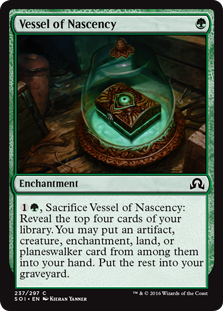
 As with madness, delirium often requires a little effort to set up. Cards that sacrifice themselves, like the common Vessel cycle, can be a good way to get a card in the graveyard—[mtg_card]Vessel of Nascency[/mtg_card] will sometimes set up delirium all by itself. Some spells, like [mtg_card]Angelic Purge[/mtg_card], allow you to sacrifice a card in play. Anything that puts cards from your library directly into your graveyard ([mtg_card]Crawling Sensation[/mtg_card], say), can add value. And, of course, discard outlets can do double duty. Balance is important here, too—you’ll need to make sure you have enough enablers that your powerful delirium cards reliably turn on, but not so much that your deck is full of low-impact effects. Look for cards that replace themselves or add value incidentally, and don’t cost much mana.
As with madness, delirium often requires a little effort to set up. Cards that sacrifice themselves, like the common Vessel cycle, can be a good way to get a card in the graveyard—[mtg_card]Vessel of Nascency[/mtg_card] will sometimes set up delirium all by itself. Some spells, like [mtg_card]Angelic Purge[/mtg_card], allow you to sacrifice a card in play. Anything that puts cards from your library directly into your graveyard ([mtg_card]Crawling Sensation[/mtg_card], say), can add value. And, of course, discard outlets can do double duty. Balance is important here, too—you’ll need to make sure you have enough enablers that your powerful delirium cards reliably turn on, but not so much that your deck is full of low-impact effects. Look for cards that replace themselves or add value incidentally, and don’t cost much mana.
Investigate and Clue Tokens—The last major mechanic, investigate, is a new keyword action. When you investigate, you put a token artifact called a Clue onto the battlefield under your control. All Clues have the ability to sacrifice themselves (for a small fee) to draw a card.
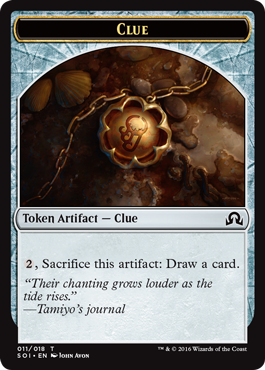
Get a Clue!
Clues show up in a lot of places. Sometimes, they’re a “rider”—a small bonus you get in addition to a larger effect. Other times, a card can give you Clues repeatedly, whenever some game action occurs.
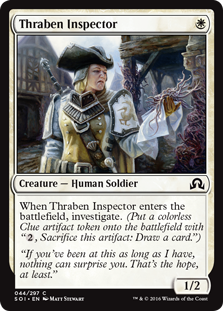
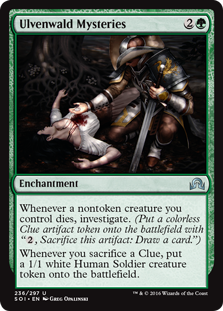
 Investigate adds some much-needed smoothing to the format. Even when it works toward a larger benefit like madness or delirium, “discard and/or sacrifice a lot” is an unappealing set theme for a lot of players. It can also lead to stalled games—you can only discard for value so many times before you miss a key land drop or find yourself without a play to make on an late turn. With a Clue token handy, you can pay a little mana (conveniently, on a turn you probably weren’t doing anything else anyway) to dig for action.
Investigate adds some much-needed smoothing to the format. Even when it works toward a larger benefit like madness or delirium, “discard and/or sacrifice a lot” is an unappealing set theme for a lot of players. It can also lead to stalled games—you can only discard for value so many times before you miss a key land drop or find yourself without a play to make on an late turn. With a Clue token handy, you can pay a little mana (conveniently, on a turn you probably weren’t doing anything else anyway) to dig for action.
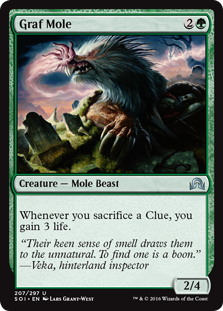
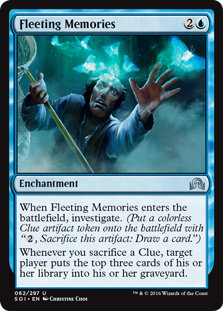
 Uncommon “Clues matter” cards give some build-around payoffs to drive Clue-focused decks. The effects on these cards vary widely, but they share a theme of turning investigate into a value engine that generates additional effects. There can be tension here: repeatedly investigating can help you find key cards, but cracking Clues costs mana and doesn’t affect the battlefield. Be sure you have ways to keep pace with your opponent while you piece together the puzzle.
Uncommon “Clues matter” cards give some build-around payoffs to drive Clue-focused decks. The effects on these cards vary widely, but they share a theme of turning investigate into a value engine that generates additional effects. There can be tension here: repeatedly investigating can help you find key cards, but cracking Clues costs mana and doesn’t affect the battlefield. Be sure you have ways to keep pace with your opponent while you piece together the puzzle.
Meshing Mechanics
These mechanics intersect in subtle ways to make for interesting play decisions. Madness requires lots of discard outlets, which can be repurposed as avenues to get additional cards into your graveyard for delirium. Werewolves draw focus to instant-speed cards, and madness creates more instant-speed windows to cast cards that can affect the battlefield. Sacrificing permanents can help turn on delirium, but if you like your cards, you can sacrifice a Clue you happen to have lying around.
There’s a lot of minor mechanical themes, too, some of which only show up on a few cards. Several creatures, like [mtg_card]Nearheath Chaplain[/mtg_card], exile themselves from the graveyard to make tokens. Some creatures return from the graveyard when you discard a few cards. Several green cards retrieve lands from the graveyard—a nice touch, because lands are what most players are likely to discard. There are tribal themes (Vampires, Werewolves, Zombies, Spirits, and Humans) for each allied color pair. There’s a bit of “equipment matters” running around.
All in all, the mechanics of Shadows over Innistrad come together to make a robust environment with a lot of texture. But how do the cards play? So far, pretty great.
Changing/Contextual Card Evaluations
In addition to the interesting ways the mechanics combine, the individual cards of Shadows over Innistrad have a lot of depth. In particular, their power can vary considerably based on what else is in your deck.
Last week I went 3-0 with a green-white humans deck, which is a good object lesson in how the power of Shadows cards can depend on the larger context of your deck:
3-0 draft at 1st Shadows over Innistrad FNM. Hyped for the format: tons of people had epic plays tonight. #MTGSOI pic.twitter.com/VhK3BXppZT
— Cute Fuzzy (@cutefuzzy_) April 9, 2016
[mtg_card]True-Faith Censer[/mtg_card], for example, was a surprise all-star. The powers and toughnesses in this set are clustered pretty tightly in the 2–3 range, so +1/+1 is a relevant bonus. (When it turned my [mtg_card]Dauntless Cathar[/mtg_card]s into 5/3s, they could push through or trade with basically anything.) With so many incidental tokens, I always had things to equip to. And when the board stalled out, even a 1/1 Spirit token could pick up the Censer to become a relevant threat.
The [mtg_card]Moorland Drifter[/mtg_card]s, on the other hand, were pretty bad. I was never anywhere close to delirium, so they were only ever 2/2s. Usually, my opponent would hold them off with a 2/3 on turn three. At that point, they were waiting to pick up the Censer before they could do anything besides double-block.
That said, I can certainly imagine the Drifters being stellar in a deck more focused on delirium. If I had drafted, say, two or three copies of [mtg_card]Vessel of Nascency[/mtg_card], they would have had flying pretty frequently. Consider this curve:
- Turn 1: [mtg_card]Vessel of Nascency[/mtg_card].
- Turn 2: [mtg_card]Moorland Drifter[/mtg_card].
- Turn 3: [mtg_card]Paranoid Parish-Blade[/mtg_card]; swing for 2.
- Turn 4: Sacrifice [mtg_card]Vessel of Nascency[/mtg_card]; enable delirium; swing for 6; play [mtg_card]Moldgraf Scavenger[/mtg_card].
Sounds exciting, right? It also sounds like an entirely different deck. It’s still green-white, and it even uses many of the same cards, but the deck’s focus and payoffs are something else. The cards that were merely okay in my draft deck seem amazing here. And conversely, Vessel of Nascency would have been fine in my deck—it always at least gives a little card selection—but it’s clearly the key card here.
That’s what really has me excited for Shadows over Innistrad limited: so many of the cards are contextually powerful. They’re decent in most decks, but have incredible potential when surrounded by just the right supporting cast. Even better, many of the cards are flexible in application: they can potentially contribute to a lot of different decks, but finding just the right shell to maximize them is a fun challenge.
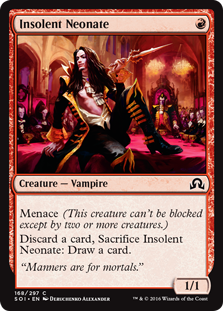
[mtg_card]Insolent Neonate[/mtg_card] makes for a great example of these aspect of SoI‘s cards. [mtg_card]Suntail Hawk[/mtg_card] is not a good limited card, and a 1/1 menace is equally unappealing. But in a dedicated madness deck, the Neonate is essentially an instant-speed discard outlet that doesn’t cost a card, which might also get in for a few points of damage. One could also press it into service in a delirium deck, where it can add two cards types to the graveyard at instant speed. And in a pinch, it could do work in an aggressive Vampire tribal deck as an early threat that’s not a total dud in the late game. It has broad applications, but its power depends on context.
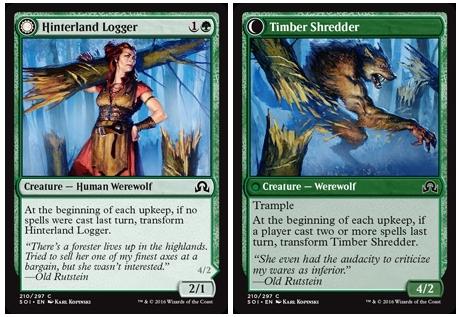 Shadows cards also have contextual power within individual games, gaining more strength as circumstances around them change. Werewolves are a good example here. They are a good aggressive archetype, as they punish slow starts; if you open on Hinterland Logger, your opponent is already in trouble if they pass turn two without a play. But because werewolves also pick up substantial stat bonuses when they transform, they remain relevant late into the game—especially so once both players have run low on spells and passing the turn with no plays becomes less punishing.
Shadows cards also have contextual power within individual games, gaining more strength as circumstances around them change. Werewolves are a good example here. They are a good aggressive archetype, as they punish slow starts; if you open on Hinterland Logger, your opponent is already in trouble if they pass turn two without a play. But because werewolves also pick up substantial stat bonuses when they transform, they remain relevant late into the game—especially so once both players have run low on spells and passing the turn with no plays becomes less punishing.
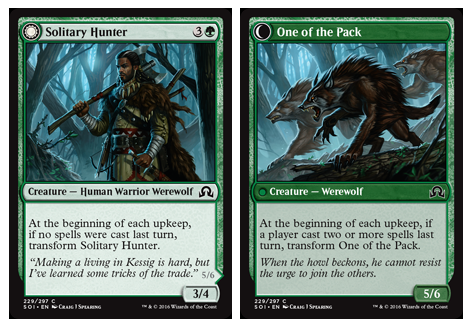
Solitary Hunter is a great on-curve play that becomes a serious late-game threat when your opponent is in topdeck mode.
Delirium works this way too. While some delirium decks will abuse it for some explosive starts, many other delirium cards gain incidental power or utility as the game goes on—essentially the way I tried to play [mtg_card]Moorland Drifter[/mtg_card] in my draft deck.
Deepening Shadows
Only time will tell if Shadows over Innistrad is truly the heir to the original Innistrad‘s legendary limited format, but I’m optimistic. The pieces of the set—the mechanics, the cards—all fit together to make a complex and interesting puzzle, so the tools are there.
I’ll be back next week with a more in-depth look at color pairs and archetypes. In the meantime, reach out on Twitter or in the comments to let me know what your most epic Shadows over Innistrad limited moments have been!
